Tangie Auto Cannabis Strain Week-by-Week Guide

- 1. Grow specifications
- 2. Grow set up
- 3. Germination and seedling stage | week 1
- 4. Early veg | week 2
- 5. Mid veg | weeks 3-4
- 6. Transition (pre-flower) | week 5
- 7. Early flower | weeks 6-7
- 8. Mid flower (bulk phase) | weeks 8-9
- 9. Ripening and harvest | week 10-12
- 10. Yield and smoke report
- 11. In conclusion
Tangie Auto offers autoflower growers a chance to get one of California's most sought-after strains in a record-breaking time as this is one of the fastest plants in Fast Buds collection. However, fast doesn't mean inferior – Tangie's yields are generous, the buds are big, dense, and easy to trim, and the final product oozes citrus-smelling terps and produces a high that keeps you happy and motivated without making you tired or overwhelmed by what's going on in your head. Tangie Autoflower may become your favorite daytime smoke, and our week-by-week guide will show you how to grow and harvest as much as you can so that your stash will last you a while.
1. Grow Specifications
Tangie Auto grows and smokes like a Sativa, but her genetic makeup is actually more balanced than that – 65% Sativa and 35% Indica. The plant's average height indoors is anywhere between 80–120 cm (31–47 inches), and her yields match the size of the plant, reaching 400–550 gr/m2 (1.3–1.8 oz/ft2). Outdoors, this plant is a terrific producer, but the harvest depends on a lot of variables, such as climate, weather, and your cultivation skills, and can be between 50–250 gr/plant (2–9 oz/plant). It's hard to believe that you'll only need 9-10 weeks from seeds to harvest that much, but with Tangie Auto it's true.

The flavor is everything you'd expect from a strain with such a name – it has a fresh citrus aroma and the juicy taste of oranges. With 23% THC, it's a very potent smoke, but it's the kind of potency that lets you function as the high is clear-headed, motivating, and mood-boosting.
2. Grow Set Up
Out of many grow reports available online, we've chosen one that wasn't smooth sailing from start to finish, but it's okay because it shows the vigor of Tangie Auto and her ability to perform even in subpar conditions.
The grower with the nickname Northernwizard grew his six Tangie Auto plants in a 3x4 tent equipped with two 600W LEDs. As a medium, he used the Plagron Lightmix potting soil and bottom-fed his plants through the Aquapot system. He didn't like it, though (as you'll see later). The interesting thing about this grow was the use of a PPFD meter (which measures the intensity of light), and we've included the numbers in weekly tables.
| Grow Space: | 1.2 m2 | Pot Size: | 8.5 l |
|---|---|---|---|
| Seed to Harvest: | 12 weeks | Medium: | Soil/Coco/Hydroton |
| Flowering: | 8 weeks | Nutrients: | Synthetic/Organic |
| Light Cycle: | 18/6 - 16/8 - 14/10 | pH Levels: | 6.8-7.0 |
| Light Type: | LED | Day Temperature: | 24-26°C |
| Watts Used: | 1200W | Humidity: | 50-75% |
3. Germination And Seedling Stage | Week 1
To start weed seeds, whether Tangie Auto or any other strain, we recommend a germination method that lets you constantly monitor the state of the sprouts – the paper towel method. It's as easy as placing the seeds between wet paper towels, covering them with a saucer, and placing the whole thing in a dark warm place. You can check every 12 hours whether the beans popped, and when you see that they have and that the tap root has grown to a half inch or so, you can put your sprout into the medium.
| Plant Height: | 4 cm | Day Temp: | 26°C |
|---|---|---|---|
| Distance to Light: | 105 cm | Night Temp: | 22°C |
| PPFD: | 300 | Humidity: | 75% |
| TDS: | – | pH: | 7.0 |
Some growers start by planting the seeds in jiffy pellets and keeping them in a propagation kit that has a heating map and a humidity dome – as seedlings love warm and humid conditions. This grower did just that, and his Tangie Autos were doing great, enjoying the perfect day temps of around 79°F (26°C) and the high RH of 80-90%. Of course, cannabis seedlings can survive harsher conditions, but those that are close to optimal give them a great headstart in life.
Cannabis seeds have enough energy stored in them to develop rapidly for the first few days without extra nutrients. Moreover, giving them nutes at this stage can actually hurt the tender roots. So, the safest bet for you is to just give your seedlings pure water. However, you can use some rooting hormones – there are plenty of them on the market. This particular Tangie Auto was getting House & Garden Roots Excelurator which is supposed to create a protective film around the roots.
Another product that Tangies received was Plant Success Great White which is a rich mix of bacteria and mycorrhizal fungi. Inoculating the medium with beneficial microbes early on is a good practice that we'd recommend for both organic and inorganic grows.
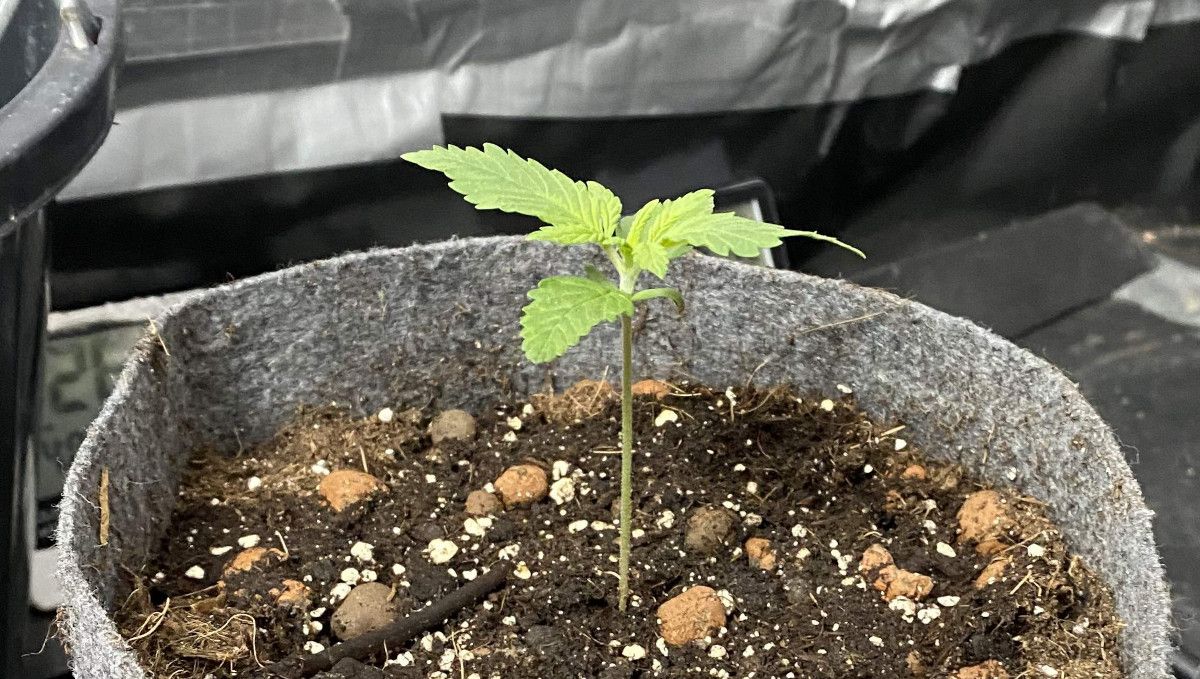
When the seedlings were big enough, the grower put them – jiffy pellets and all – into final containers filled with a potting mix. In his case, it was gardening soil with perlite mixed in plus some coco coir and expanded clay pebbles. These additives serve to make the soil better at retaining moisture and creating enough air pockets for the roots to breathe. Using textile bags or non-woven bags serves the same purpose btw – giving the root ball more oxygen.
For this Tangie Auto grow, the gardener used 8.5-liter (2.25-gal) bags which is enough if you fertigate frequently. If you're unsure about your growing skills or want to water only once in a couple of days, maybe you should use bigger pots – up to 5-6 gallons. More than that is hardly necessary for an autoflower.
4. Early Veg | Week 2
In the 2nd week, the seedlings are not so vulnerable anymore and you can start lowering both the day temps – to around 77°F (25°C) – and the relative humidity, which can be safely lowered to below 60%. As for the night temps, keep them lower than the day temps by 5-10 degrees to let your plants cool down and have some rest. Btw, you can grow many autoflowers under a 24/0 light schedule, but most gardeners think some night rest is necessary and use the classic 18/6 light cycle.
| Plant Height: | 7 cm | Day Temp: | 26°C |
|---|---|---|---|
| Distance to Light: | 105 cm | Night Temp: | 22°C |
| PPFD: | 300 | Humidity: | 75% |
| TDS: | – | pH: | 7.0 |
The second week from seeds is the time when the seedling that has been developing very slowly until now finally goes into a higher gear and shows noticeable progress every day. New true leaves keep emerging – the first pair has just one leaflet, the second three leaflets, and the third five. If everything goes well, each new pair is bigger than the one just below. If not, check whether you're doing everything right as there must be a reason your young plant has slowed down. The Tangie Auto in the pic below is doing just fine.
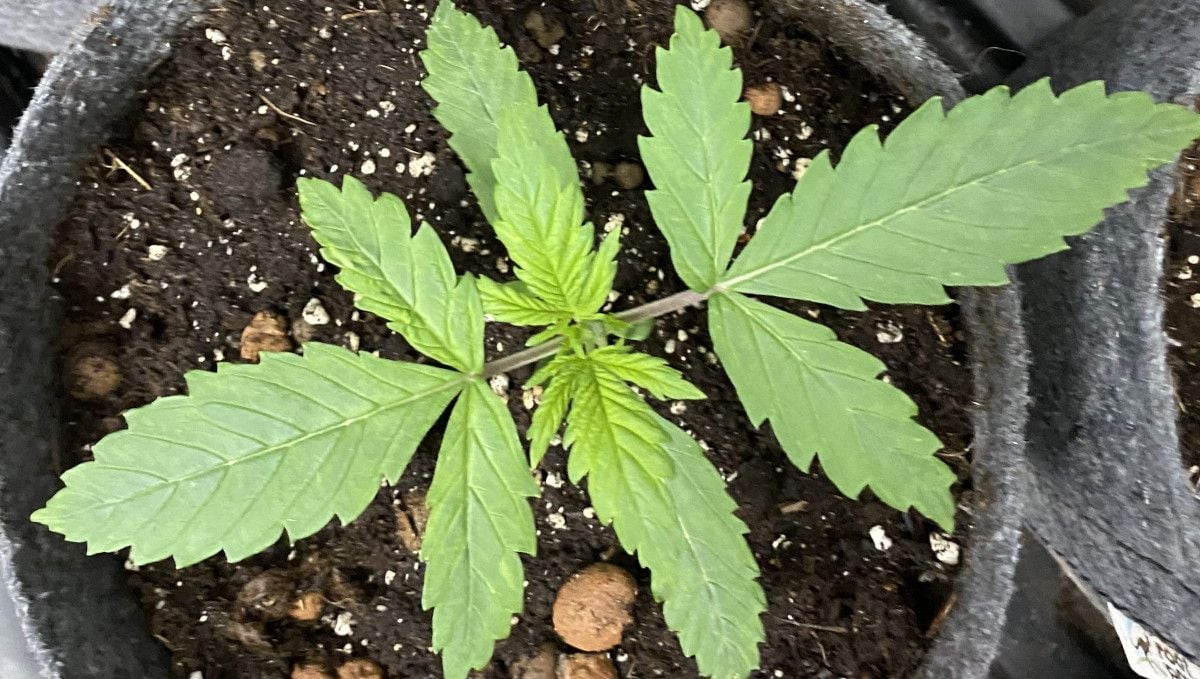
When you grow in soil, you can still use nothing but pure water as most potting mixes come pre-amended with enough nutrients to last quite a while. With autoflowers, you'll probably start feeding at the end of the vegetative stage or maybe even when the flowering begins. (There're some gardeners who take big containers and prepare super soil which lasts their autos from seed to harvest.) The Tangie you see in the pic above was still feeding on the nutes in the root zone and was only drinking water plus a root stimulator and a microbe inoculant.

5. Mid Veg | Weeks 3-4
Once active vegetative growth starts, it keeps building momentum, and you begin noticing something new on a daily basis. And not just new nodes on the central stem or new leaves. Around this time, side branches also start to develop in earnest. Of course, the nutrients in the root zone quickly deplete, especially if there wasn't much medium, to begin with. So, most growers begin to introduce some extra nutrients as you can see in the table below – the grower started to specify his TDS readings.
| Plant Height: | 15-30 cm | Day Temp: | 26°C |
|---|---|---|---|
| Distance to Light: | 100 ↘ 75 cm | Night Temp: | 22°C |
| PPFD: | 450-550 | Humidity: | 55% |
| TDS: | 150 ppm | pH: | 7.0 |
Since most autoflowers enter the budding stage sometime in the second half of the first month from seed, you shouldn't waste any time if you plan to train them. The purpose of training is to make your autos bush out and thus form compact and flat canopies. When most of the bud sites are at a more or less equal distance from the light, they turn into large and dense colas. Otherwise, the size and texture at different distances vary too much.
If you have just a few plants and have enough time and patience, low-stress training (LST) is the best method. This grower, however, chose to top his Tangie Auto plants. They all proved strong enough to take this potentially stressful procedure in stride.
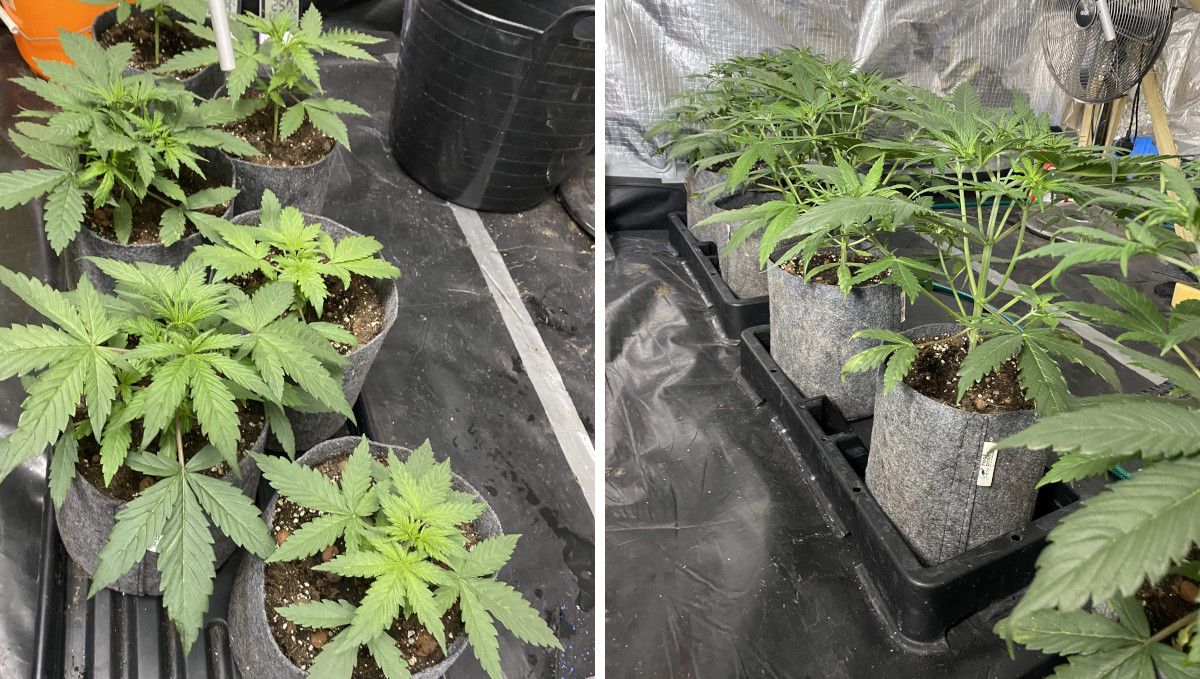
To sustain rapid vegetative growth, you'll need to give your autoflowers enough nutrients. Nitrogen (N) is the most important at this stage while the other two macronutrients – phosphorus (P) and potassium (K) – play only a minor role. So, choose a product with the correct NPK. Of course, cannabis needs many other essential chemicals, but all good formulas designed specifically for this plant contain them. For his Tangie Auto garden, the grower also used a Cal-Mag supplement as the deficit of these two is very common, especially in coco grows but in soil as well.
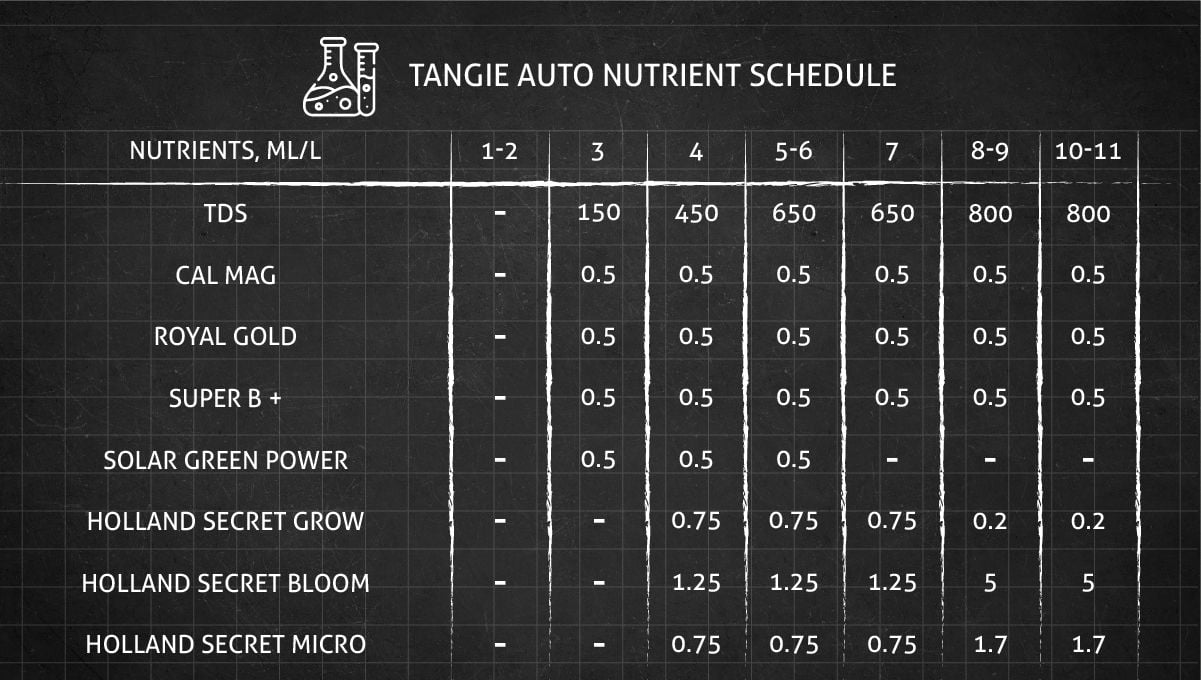
6. Transition (Pre-Flower) | Week 5
When autoflowers enter the flowering stage (and this happens around the end of the first month), they start drinking and eating more than before. Water them regularly but allow for some time between waterings so that the medium dries out somewhat and the roots have a chance to breathe. Gradually raise the TDS levels of your nutrient solution, too. You may also start lowering the temps by a degree or two and the RH or may leave this step for later – when the buds start to fill out and produce resin in earnest.
| Plant Height: | 30 cm | Day Temp: | 26°C |
|---|---|---|---|
| Distance to Light: | 75 cm | Night Temp: | 22°C |
| PPFD: | 650 | Humidity: | 55% |
| TDS: | 450 ppm | pH: | 7.0 |
You may miss the moment when your autoflowers first show sex – for that, you need to look very closely at the nodes inside the canopy where tiny white female hairs appear at some point – but you'll hardly miss the moment when your autos begin to transition. The first sign is that the tops change color to a lighter green. Then you'll see that instead of new leaves, many greenish-white hairs begin to grow on tops. These are future buds.
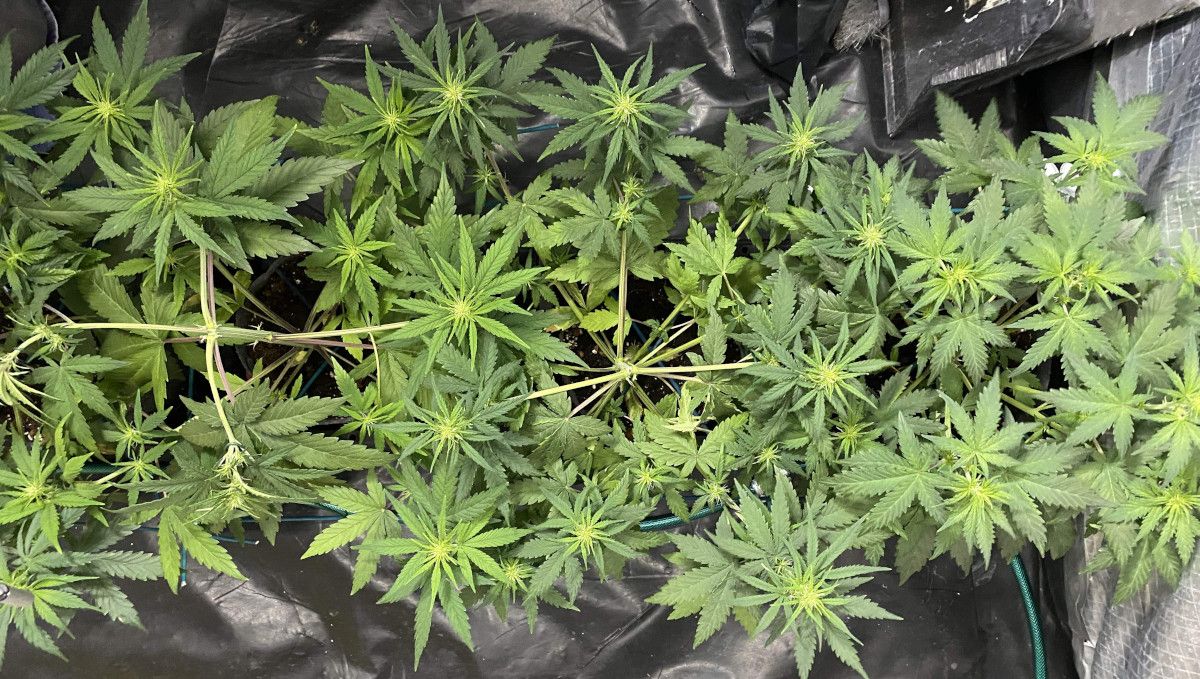
In the pic above, you can see how topping plus the tie-down method resulted in a very flat canopy with potentially great results in terms of the size and texture of the buds. You may also have noticed that the leaves of Tangie Auto plants are somewhat yellow and not only on top. This is what a deficiency (probably a Cal-Mag deficiency) looks like. Please note that cannabis deficiencies don't necessarily start when plants don't GET the necessary nutrients with water. More often than not, they DO GET all essential nutrients but can't ABSORB them because of a pH imbalance. This was the case with this Tangie grow. Read on.
7. Early Flower | Weeks 6-7
A huge stretch is probably the single most conspicuous thing that happens in the early stage of flowering. It's too late now to LST, so, all you can do is just watch how the branches grow longer and longer and hope this stops before the tops reach the light. One of the best things about autoflowers btw is that they seldom grow too big for even small indoor setups, and these Tangie Autos were no exception. As you can see in the chart below, their growing stretch was minimal.
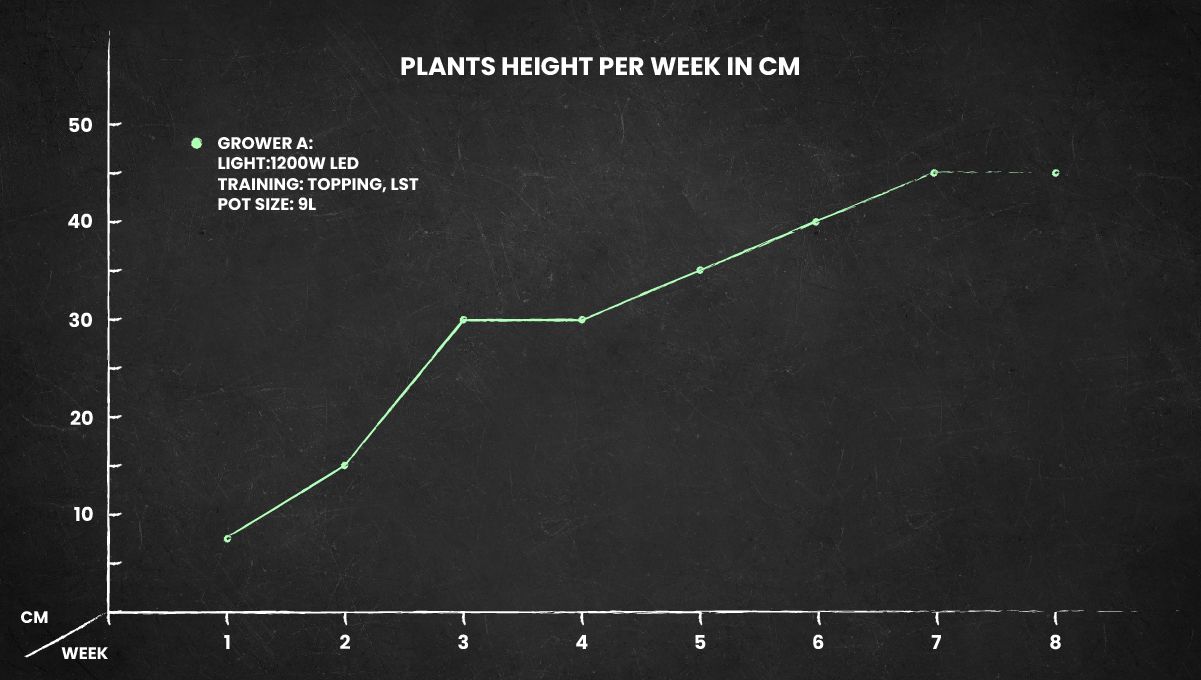
You may also notice how the grower lowered the day and night temps as well as the relative humidity. Keeping things a bit cooler helps conserve both cannabinoids, such as THC and CBD, and terpenes, which are volatile chemicals that give cannabis its characteristic aroma. Lower RH helps prevent mold and bud rot.
| Plant Height: | 35-40 cm | Day Temp: | 26°C ↘ 24°C |
|---|---|---|---|
| Distance to Light: | 70 cm | Night Temp: | 22°C ↘ 20°C |
| PPFD: | 650 | Humidity: | 50% |
| TDS: | 650 ppm | pH: | 7.0 ↘ 6.8 |
All through weeks 6 and 7, the grower kept struggling with deficiencies. His first guess was that he should have started feeding earlier in the vegetative stage, so he upped the dose of nutrients now. That didn't help. He then speculated if there was an issue with his irrigation system.
He was using the so-called Autopots which bottom-feed the plants (from a tray). Autopots take the water automatically from a reservoir and thus make your life easier. On the other hand, they tend to leave the top layers of soil relatively dry and cause salt build-up there. The grower knew about this, so once a week, when he was changing the reservoir, he watered his Tangie Autos manually from the top to flush down the excess salts. That didn't help either.
Finally, he found out the reason for his troubles – his pH meter had been calibrated wrong, and so, pH levels were way off. The lesson here is that the more bells and whistles you have in your setup, the more you depend on the technology and that can backfire on you. In particular, if you don't want to bother with pH, grow organically – the yields may not be as spectacular but the process will be much smoother.
When the grower finally solved his puzzle, he flushed the medium, using only Future Harvest Plantacillin (a booster of enzymatic activity) and Carbo Blast, aka Trichome Booster (a source of carbohydrates). Despite all the trouble, Tangie Auto buds continued to fill out.

When the pH levels were brought back to normal, the spread of discoloration stopped. The color of those leaves that had been already affected didn't improve, but the rest looked healthy.
8. Mid Flower (Bulk Phase) | Weeks 8-9
The bulk phase is when cannabis plants are the thirstiest and the hungriest. Be sure to give them plenty of water and nutrients and also don't forget that they need much more P and K and much less N compared with the vegetative stage. Many growers even use special PK boosters around this time. Others reserve it for later – for the last week or two before the final flush.
| Plant Height: | 45 cm | Day Temp: | 24°C |
|---|---|---|---|
| Distance to Light: | 70 cm | Night Temp: | 20°C |
| PPFD: | 650 | Humidity: | 50% |
| TDS: | 650-800 ppm | pH: | 6.8 |
In addition to buds getting big and dense, you'll notice another major change now – the emergence of trichomes on every calyx and little leaf. Besides THC, these tiny resin glands also store up terpenes, meaning that your plants begin to smell. Even with one autoflower, you'll probably need a carbon filter. With six Tangie Autos (like in this garden), odor control is an absolute must.

Most growers want to keep the same light schedule from seed to harvest (usually, it's 18/6), but this one thought his Tangies were getting too much light so he changed the schedule to 16/8 in week 9 and to 14/10 in the last two weeks leading to the harvest. The thing is that he used very powerful LEDs and there wasn't enough vertical space to raise them (nor could he dial them down).

9. Ripening And Harvest | Week 10-12
When the buds are fattening up and getting denser by the day, you need to give them the last boost with phosphorus and potassium and find the right moment to start flushing (more of that below). So, your TDS levels will probably be the highest now. As for the temperature, it should stay moderate during the day and you may lower it during the night – to emulate cooler autumn weather and bring out the purple color if your particular strain has some purple genes.
| Plant Height: | 45 cm | Day Temp: | 24°C |
|---|---|---|---|
| Distance to Light: | 70 cm | Night Temp: | 20°C ↘ 18°C |
| PPFD: | 650 | Humidity: | 50% |
| TDS: | 800 ppm | pH: | 6.8 |
The Tangie Auto buds were coming along nicely and looking more and more mature, so the grower started to monitor the state of the trichomes. You do this through a 60x jeweler's loupe, and when most of the buds look cloudy to you instead of clear, it's time to flush the medium of built-up salts. This procedure cleans not only the medium but the buds themselves so that they burn smoothly and taste incredible. As a side effect, it makes big fan leaves turn yellow and brittle. Not the prettiest site, but the smoke will be the best and the buds will have all the bag appeal you want after you've trimmed them.
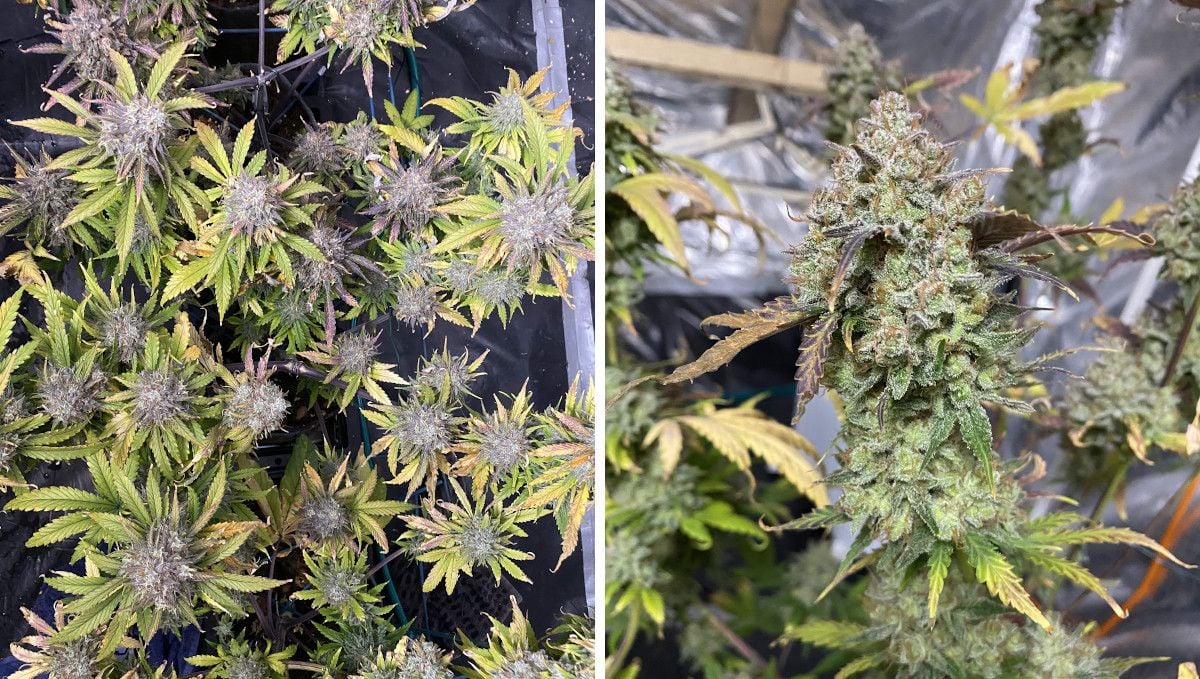
Most growers harvest their plants after a week of flushing (in hydroponics) or two weeks (in soil). Make sure that on the chop day all of the trichs are cloudy and a few of them have started to turn amber – this is the moment when THC content is the highest.
10. Yield and Smoke Report
Six autoflowers can provide even the heaviest of users with enough smoke to last till the next harvest. These six Tangie Autos brought 12.5 ounces (354 grams) of well-manicured bud despite all the trouble. In better condition, the results could've been even more spectacular.
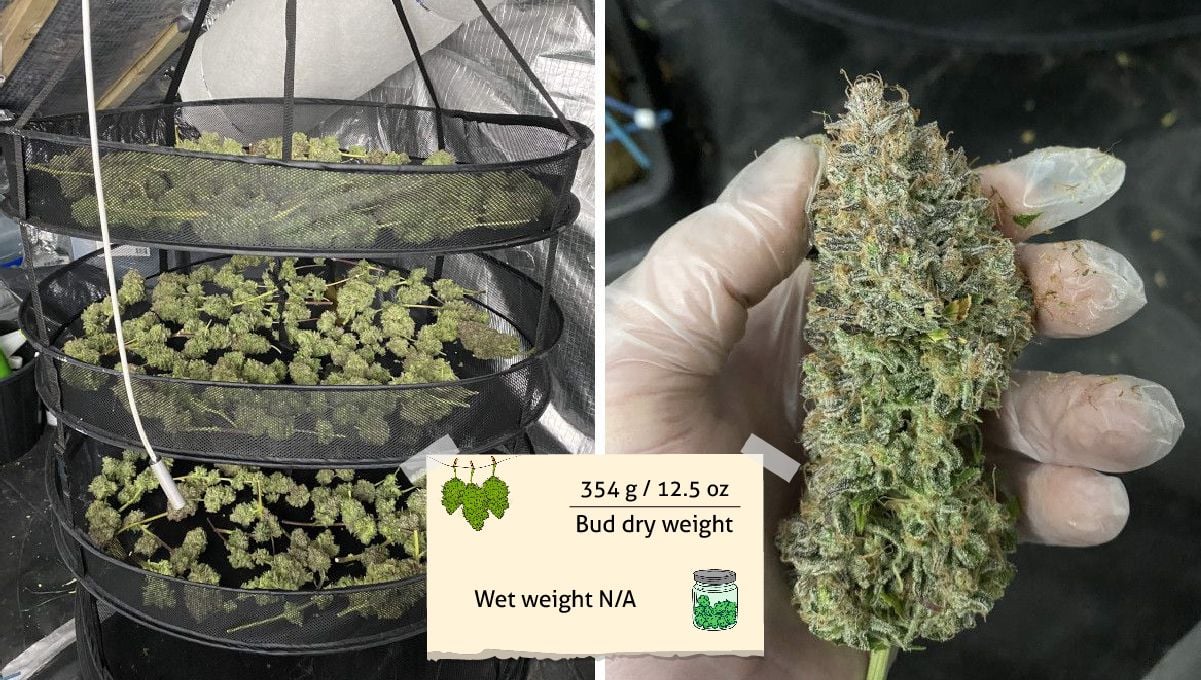
The grower spoke highly of the smoke. The buds smelled like oranges in the grow room, but the taste ended up being more sour than sweet – like lemon. The high was like a shot of pure joy – as one would expect from a Sativa. It made you happy, uplifted, and full of energy.
11. In Conclusion
In the grow that we picked for this review, the Tangie Auto strain performed incredibly well despite the suboptimal conditions. It responded great to high-stress training, staying short for a dominant Sativa, and produced big, dense, and frosty buds that were also easy to trim. With its significant yield potential and the highest quality of the smoke, Tangie Auto should be on the radar of commercial growers while amateurs will appreciate all that plus the plant's vigor and resistance. Whether weed cultivation is your day job or hobby, you can't go wrong with Tangie Auto. Happy growing, everyone!








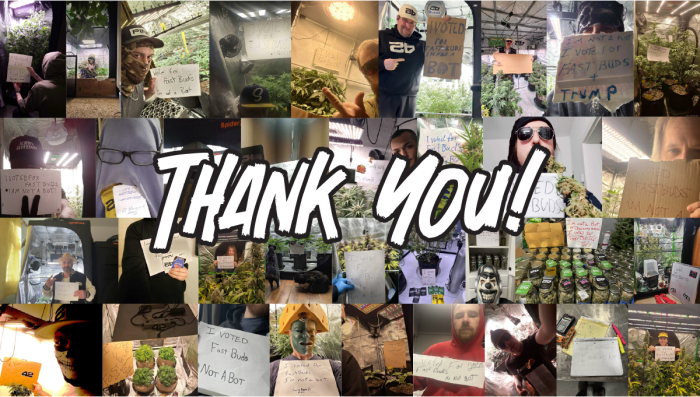

Comments